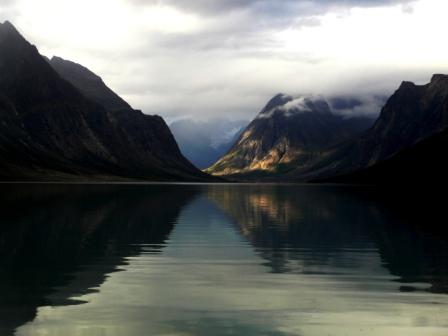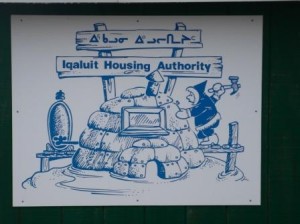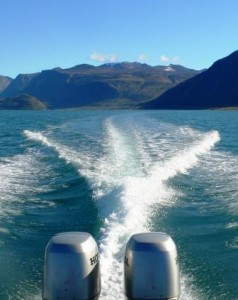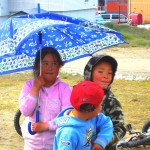The Supreme White Hunter At The End Of Nature
Avoid eye contact, say nice things if you can think of any, and never, ever run!
The great white whale is a monstrous force of nature in American lit, but after walking among the relics of an Arctic whaling station established about the time Moby Dick was published, I saw that nature

lost. The bow whale is long gone from the ice edge. The ice itself is receding. As the title of an early book on global warming suggests, we have seen “The End Of Nature.” I heard a Lakota spiritual leader say a white buffalo, among other white creatures, will be the sign of the rectification of nature, but I do not believe its time has come.
In this dark mood I returned from an aborted trip to an incredible wild national park in the Canadian Arctic that among other things has the tallest, sharpest granite exposures on the planet.
Sadly, I decompressed the down winter bag and parka, put away the backpack, stowed the unopened freeze-dried dinners. I uploaded pictures and began clicking through shots of rusted blubber hooks and rendering pots and oil barrel hoops and bones, some human. I had no live pictures of the great white predator that closed the park and redirected our trip from adventure tourism to cultural tourism. I never saw him. I mean, there were pictures of him stuffed at the airport terminal in Yellowknife and at the visitors center in Iqaluit – he is the foremost symbol of the Arctic – but we did not see him live and in person. Too bad. The whole trip was defined by a polar bear. Or the fear of one.
It all began last March when my traveling partner Pat wrote an offhand bid in a silent auction at a benefit for children’s diabetes. At the end of the day we were the owners of two First Air tickets to Pangnirtung, Nunavut. At her house we went immediately to an atlas and the Internet. Pang, as it is called for short, is a town of about 1,300 Inuit people in a fiord on Baffin Island, the third largest island in the world, across the Davis Strait from Greenland. The town is accessible only by air and, part of the year, by water. Nunavut, created in 1999, is the Canadian territorial state that embraces the homeland of the Inuit people, famous worldwide as igloo-dwelling, dog-sledding Eskimos.
We discovered that at the head of the Pang fiord is Auyuittuq National Park, essentially a 95-kilometer trail through sharp mountains from the Cumberland Sound on the west to Davis Strait on the east. The park is managed as wilderness, except for emergency shelters with short-wave radios set a day’s walk apart. They are braced against high winds and fierce bears. The park became our destination.

The North is another country, a new country rich in things to come, a harsh frontier with a rapidly moderating climate. The ice is melting. The Northwest Passage is no longer an adventurer’s fund-raising fantasy. This new country has oil and diamonds and fantastic tourist attractions. It’s still an exploitative frontier in the tradition that drove whales to near extinction but with a distinctively Canadian ethic that somehow, so far, has saved native people and predatory bears.
Because of the constraints of vacation time, the layovers required by First Air scheduling and a necessary allowance for weather delays, we set aside only four days for walking in the park. We would backpack from the south entrance to the high point of the pass and back. Before leaving Edmonton in mid August we spent a week packing and unpacking our stuff, trying to get the right balance of light weight and protection against the battering winds and rain and the right gear for fording ice-cold tributaries of the thundering Weasel River.
It took four days to fly to Pang. Our first hop by First Air was to Yellowknife, capital of the Northwest Territories. We spent the night in a bed and breakfast and walked everywhere in intermittent showers. Pat knows this town at the north shore of Great Slave Lake, a huge body of fresh water that is a lake in the same way that Baffin is an island. When she was married and in law school she would sometimes hitchhike to the north with bush pilots to visit her husband, who flew helicopters. We climbed to the pilots’ monument on a granite hill at the head of the spit of land called old town, and Pat remarked that Yellowknife owed its existence to courageous bush pilots.
Beginning with a gold rush in the 1930’s, they kept the town supplied, flying single-engine float planes of the kind we saw parked like cars at small docks and even houses along the shore. The planes with their canoe-size pontoons looked to me like they’d never get airborne, but we watched them do it. Big planes now stream into the airport near the new town, a cluster of tall steel buildings including the head offices of a spectacular diamond minding company. The city seems out of place in the midst of the basically uninhabitable Canadian Shield, which is a expanse of granite covering half the nation, oldest rock on earth, pocked with tens of thousands of ponds and lakes. A tortuous highway goes to Yellowknife, but it’s closed when the ice stops the ferry but is still too thin for vehicles.
We had beer and caribou burgers at the restored Wildcat Café, built out of logs the year I was born and therefore older than anything most of the young men around there have ever seen. I say men because, as Pat pointed out, the North is “a man’s world.” On our next hop, in a Hawker with a sliding partition between the passenger and freight cabins, almost every bobbing head had a baseball cap. Of about 30 passengers only three were women. The proportion would get more lopsided as we went on.
After a brief stop at Rankin Inlet, we hopped over Hudson Bay to Iqaluit on Baffin Island at Forbisher Bay. Iqaluit is the capital of Nunavut. Most of the signs are in three languages: English, French and Inuktitut, the language of the Inuit written in a phonetic alphabet dating from the 18th century. The

curvy fiberglass creations with maximum insulation and minimum windows. They look like they could ascend quietly at any given moment to the mother ship. The airport with its yellow bolted steel terminal is the center of activity, and most activity is arrivals or departures of freight and local people.
The rain was cold and I bought a heavier waterproof parka at a place called Arctic Survival Store. We visited small galleries and the visitors’ center with the stuffed bear and a caribou. We stayed at the Frobisher Inn, which had French employees and a restaurant with beautiful Pangnirtung prints on the walls and $20 hamburgers on the menu. We spent much of the next day at the airport waiting for our flight to Pang, which after numerous postponements was cancelled. I memorized the contents of a half dozen display cases of Inuit art from various Nunavut communities.
The most popular art is stone carvings of animals, humans and spiritual beings. Sellers circulate in restaurants and hotel lobbies. At dinner in a crowded Chinese restaurant the second night a girl brought around a carving of a dancing bear that, I supposed, would be worth $1,500 in Banff or Lake Louise. Pat eventually bought it for $450, and it now dances on a cabinet in her art-filled living room. It’s a lovely bear, but I was more attracted to the white marble one in the airport, heavy and powerful with all four feet on the ground and his long neck extended ominously. Hunter sniffing out prey.
The weather lifted enough for our one-hour flight in the evening of the next day. At Pangnirtung we checked in to the Auyuittuq Lodge, a basic frontier boarding house with rooms barely big enough for two twin beds, toilets down the hall, and meals at long communal tables. Rate: $190 a day per person. The other guests were construction workers from the south who were building a community medical center. Most of them were anxious to finish the job and get out of there. The town has no cafes or bars, and the local ban on alcohol is strictly enforced.
Pang, we discovered, has an exemplary artist’s cooperative, focused on print making. The original prints, from lino blocks or stencils, are signed and numbered and sold in limited editions of 30 to 70. The annual catalog goes worldwide. Pat took a liking to Andrew Qappik, who was at work in the print shop, and she bought three of his stencil prints. We learned later that he is quite famous and was the designer of the Nunavut flag (a bear and the North Star). I returned later and bought one of his prints – a mother bear walking on the ice with her two cubs, casting shadows the color of the sky.
The next day, a Thursday, in terrible weather we sought boat transportation to the park on Friday and bought three-day permits at $75 each at the park headquarters in Pang. We were group No. 60 this year, and it was near the end of the hiking season. In the mandatory orientation, the Inuit ranger made sure we had the bear pamphlet, which says don’t run if confronted but avoid eye contact and talk in a soothing tone. He suggested using our hiking poles as weapons if attacked, but he said not to worry: if we wanted to see a polar bear we’d be better off going to the Toronto zoo. We spent the rest of the day walking in the rain up a trail beside a torrent pouring off the mountain that overlooks Pang. The alien environment was beautiful – the fresh air, the white noise of the river, the clouds at the crest, the softness of the deep tundra. The nearest tree, it is said, is 600 miles away.
At dinner there were two new guests, retiree travelers Hugh and Lily, slumped over dessert, exhausted. They had just returned from three days in the park – three days of cold rain – and they were happy to be under a roof and not in a wind-bent tent. They didn’t regret the once-in-a-lifetime experience, not even wading the streams, and their attitude helped clinch our decision to go, rain or shine.
But I was getting worried about transportation. I had left several messages with a man called Joavee, said to be the best. But, no response. Hugh and Lily said not to worry, that he had taken them to the park and picked them up and that he was totally reliable. Sure enough, minutes later a serious man with classic Inuit features introduced himself. Joavee Alivuktuk. He set our pickup time for 8 the next morning, at high tide. Boating in the Pang fiord depends upon the tide, which surges incredibly to more than 20 vertical feet. A boat that is anchored and afloat in deep water at 6 a.m. can be beached 200 feet from the water’s edge at noon.
We awoke to a bright sunny day. Hugh and Lily at breakfast said it was the first time they’d seen the sun since they arrived in Pang, and they were so

envious. Others said it was the best morning in weeks. As 8 a.m. rolled around we checked out, stashed our baggage and brought our packs to the lobby. We said goodbye to Hugh and Lily, who wished us well. We felt lucky. But when Joavee arrived he looked me in the eye and said, “Bad news.”
What?
“The park is closed. There is a polar bear. . . .”
The previous evening, a patrolman sitting at the south entrance on the porch of the ranger cabin saw a bear hunkered down on a rock near the trail. A young woman with a pack was walking along, oblivious. The patrolman, a bright young Inuit named Matthew, told me in an interview later that he knew he could not yell a warning to the girl because she might panic and run, which would trigger the bear’s instinct to attack. So he got his “bear banger” and fired it and the bear ran south along the shore of the fiord and disappeared in the rocks. The girl came up to the ranger and asked why he fired the gun. Was it a signal that high tide was coming?
Matthew pursued with the blanks gun but could not find the bear. He identified it as a male about three or four years old. The bear might have kept going south, which was good. Or he might have doubled back during the night, which posed a threat to the some 20 backpackers at various places in the park. The patrolman radioed headquarters in Pang, where rangers began broadcasting radio bulletins advising everybody to buddy up and spend the night in the shelters. And they closed the park to new visitors, and order that immediately affected only us two. So what would we do now? Well, there was this historic whaling station about two hours by boat south of Pang. Soon we were skimming along in Joavee’s boat, a wooden hull with twin Honda outboards roaring. Smile.
The Kekerten station was established by Scottish whalers in the late 1850’s and joined later by Americans. It was typical of the eastern Arctic operations

that wiped out 30,000 bowhead whale, now an endangered species with perhaps 500 individuals left alive. The harpooned mammals weighing around 90 tons were dragged up the gentle slope of the island and cut up for blubber, rendered in iron cooking pots. The oil was kegged and shipped off to be bottled as lamp fuel or to make soap. Some of the whale “ivory” was useful for manufactured goods, but the rest of the carcasses were wasted. The relics at the now uninhabited site were mostly rusted iron implements, the wood of the buildings having been salvaged long ago.
Pat found a human jawbone and a human skull at different locations. Everyone we told about this reacted without surprise, saying many died and many are buried at Kekerten Island. The whalers employed local Inuits in all their operations, paying in weekly distributions of biscuits. Joavee took us on a guided tour along the board walks, from marker to marker thoughtfully placed for tourists. He taught us a traditional game that involved throwing seal bones and we concluded with throws for wishes. Only Pat won the throw. She wished for a polar bear. Careful! Joavee left us to wander by ourselves, saying, “If you see a bear, don’t run.”
Franz Boas, the architect of modern anthropology, made Kekerten Station his base during field work among the Inuit in 1883-84. His “The Central Eskimo,” published in 1888, is a relevant and readable classic. Boas learned the language and lived with the people. He paid attention to their stories, games, kinship, tools, food and – an innovation then — their interaction with their environment. He reported with scientific objectivity. Boas was a native of Germany, but his work was shunned there because he was a Jew. He found a refuge in the United States, serving for decades as the founding chair of the Anthropology Department at Columbia University.
Boas, trained as a physicist, is probably a good source for what the climate was like at Baffin Island 124 years ago. He visited Pangnirtung fiord in mid October 1883 with a group of Inuits hunting seals, their main staple, which he said were “found in abundance everywhere.” Describing an expedition to the head of the fiord in a letter, he said, “The glacier snout here is about 200 feet high.” There is none there now. He walked about six miles up, probably following the route of the current park trail, and saw a glacial avalanche. Nothing in park literature mentions such things now.
Joavee did not talk much about climate change. When I asked him about it at Kekerten, however, he did point to a mountain which he said used to be white year round. No sign of an ice field there now. One advantage Kekerten for the whalers was the abundance of bowhead whales, described as ice-edge dwellers. A photograph of the whaling station site in a book of Boas letters and journals also happens to show that the cove is full of broken-up ice. It was taken in August 1984, about the same time of year as our visit. From approximately the same location we saw absolutely clear water.
Back at Pang in the late afternoon we were told briskly that the boarding house was full. We had lost our room. Joavee said we could stay at his place – at the usual home-stay fee. It would be an interesting two days. His wife, Leetia, one of the Pangnirtung artists, cooked stews, chopping meat with an “ulu,” the traditional knife shaped like a crescent with a T-handle. (Boas described many of them.) Leetia and Joavee adore their grandson, whose mother, their daughter, was away looking for work. He sleeps with them. Their son and his girlfriend and an infant second grandchild were staying in the second bedroom, we in the third, which belonged to their daughter. (Boas found that Inuit social order centered on the family.)
On Saturday, our last full day, we took a morning run at the park headquarters only to be handed a refund of our permit fees by a ranger who said he could not prohibit us from entering the park but strongly discouraged it. Joavee said he’d give us a ride to the park entrance in the evening when he was scheduled to pick up two hikers coming out after ten days. We spent the rest of the day on a leisurely hike up the river again and down the soft, pleasurable tundra of the mountain side.
Along with a patrolman and his grandson, Joavee took us toward the park in a gathering storm at about 7 p.m. The twin Hondas left a long wake in the gray water. Near the park he throttled down and cruised close to the shore as we all looked for something white. Nothing. The tide had not yet come in, so Joavee tied up at some rocks about a mile from the ranger cabin. We jumped ashore and began walking north. We met two hearty young women with huge packs going south, Joavee,s passengers. They were Canadian biology graduates, one working on her doctorate, on a break after a summer of bird-banding higher in the Arctic, and they were having a fine time.
We walked on, Pat ahead and I trailing. The mud in the tidal plane was sticky. About half way to the cabin, I noticed a distinctive print in the mud. Large as a dinner plate. Five sharp claws. There were others, and I followed the tracks for a few yards until they disappeared in the rocks. He had been going south. I called Pat back to look. Well, she had gotten only a piece of her wish, but she’s new at throwing the bones. And besides, she said later, nothing is ever certain in the North.
Clicking through pictures at home I thought about what a strange year it has been. We had two summers, cold antipodal summers – Tierra del Fuego in January, Baffin Island in August. My posting here about the southern trip was obsessed with the sad story of the Yamana people, the now extinct Antarctic counterparts of the Inuit. I wondered if the Inuit will survive.
Yes they will. A friend who does Indian law told us of bundling up and taking a walk around the Frobisher hotel on a day in early February a few years ago. It was so cold and windy she thought she might not make it back to her room. When she did, she looked out the window and saw children playing soccer at recess in a school yard. She said that after severe storms in deep winter people go house to house, apartment to apartment, to see if everybody is OK.
I recalled the traditional dog sleds with their ingenious system of lashed planks stored all around Pang for the summer. The Inuit don’t use dogs anymore, but sleds are essential in winter. They pull them with snowmobiles. I recalled the traditional seal skin mukluks hanging in the entry room at the Alivuktuk home and how Joavee warmed and smiled when one of the women backpackers bought a couple of seal skins from him and asked him how to soften them for sewing. I recalled Leetia’s deft handling of the ulu and how she and her husband were teaching their grandson Inuktituk, which is clearly the first language of Pangnirtang. I recalled babies riding the backs of their mothers, warm and happy under traditional hoods that cover both. And the artists: how they unpretentiously blend together the spirits of the land, human spirits as well as the others. Yes, they will survive. I hope that we will too, leaving our machinery of death to rust on the shore.
A photo popped up that I had ignored at first. And suddenly it spoke to me of the Inuit. As Pat and I were walked through Pang after a hike up the mountain, a little girl with an open flowery umbrella, its ribs askew, came parading along the dirt street accompanied by two boys. It was not raining, but rain was not the point. What I saw was playful mockery of our overbearing culture. After all, umbrellas look pretty stupid in the Arctic. They belong in New York City protecting $1000 suits and hair jobs from what remains of nature. The kids were having such fun. They let me take their picture, and they went on joyously, speaking the language of their kin. . .
As I drove the last mile home in the Colorado Mountains I saw a rounded black shadow in the twilight ambling down the middle of Moonlight Way, sniffing the air as all bears do. It turned and saw the car and bolted into the dark piñones. I thought, that’s no bear. Bears are nine feet tall and off white. They are supreme hunters. They can smell a seal through ice. They can swim under water. They can run (and perhaps when no one is watching, dance). They have evolved from the grizzly, which was killed off in most of the West as we, the most dangerous white predator of all, advanced. Like literary whales or folklore bison, polar bears are mystically white – but they are not imaginary. Some 20,000 of them live an increasingly stressful life around the polar ice cap, it is said. I pray that they will survive because they are a sign, maybe the last sign we’re going to get.

